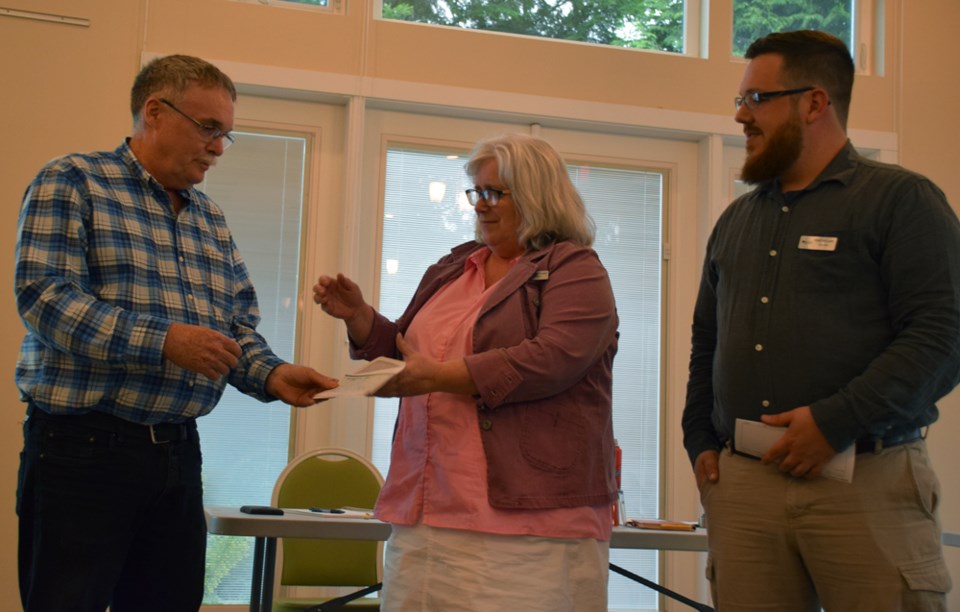2018 was a record year for revenue, according to the year-end financial report presented at the Sunshine Coast Community Forest’s (SCCF) May 13 annual general meeting.
The SCCF brought in $3,647,458 for a profit of just over $1.2 million.
As a result the SCCF board voted an extraordinary dividend of $600,000 to the sole shareholder, the District of Sechelt, as well as a regular dividend of $25,890.
Sechelt councillors Brenda Rowe and Matt McLean were on hand to receive the dividend cheques on behalf of the district.
“The extraordinary dividend is the second highest ever and reflects our plan to declare an extraordinary dividend next year even if our profits are lower,” SCCF board president Geoff Craig said in his written summary of the year’s activities.
He also said the final tally for legal fees associated with fighting a court challenge against logging in the East Wilson Creek area amounted to more than $85,000.
Operations manager Dave Lasser said the Community Forest was able to get its harvested timber on the market in time to take advantage of good prices for hemlock and an overall strong market that hit a peak in June 2018.
“We were able to ride that wave fairly successfully,” said Lasser, who noted that prices are yet to recover.
It was also the Community Forest’s best year to date for sales to local independent mills, with Sunshine Coast firms taking more than 1,000 of the 28,300-cubic-metre harvest. Sales to Howe Sound Pulp and Paper accounted for about 3,200 cubic metres and other Canadian customers took 22,371 cubic metres.
Lasser said the Community Forest is expecting to get permits in the fall for cutting in three areas, after reviews by the shíshálh Nation and Ministry of Forests, Lands, Natural Resource Operations and Rural Development.
He said work in 2019 and 2020 in the areas of Angus and Burnett creeks between Chapman and Grey creeks and in Halfmoon Bay should provide the final 30,000 cubic metres called for under the five-year cut control plan.
Lasser also highlighted two major challenges in the Community Forest tenure area – firewood poaching and illegal dumping.
Lasser said the firewood poaching has hit “epidemic proportions” with hundreds of trees being felled illegally every year, more often than not using dangerous and wasteful cutting practices.
He gave examples of trees dropped across roads with only the easily accessible sections taken and the rest left as waste, and one tree abandoned when it got hung up only to fall unexpectedly later.
“We hand out free firewood permits. Anyone who wants one can come into the office and get one,” he said. “We’ll give you a map and tell you where you can go to get your firewood … but these folks are determined to go out and do their own thing.”
Lasser said catching and fining the people responsible is difficult, but they were able to get enough evidence to forward one case to the province and charges are expected soon.
He also said the Community Forest has been forced to use obstacles on some roads to make it impossible to get pickup trucks through.
Lasser said the illegal dumping he’s seen in recent months includes garden waste containing potentially invasive plants was well as the usual assortment of abandoned appliances, electronics, and even vehicles.
The SCCF board also heard a presentation from shíshálh Nation hereditary chief Garry Feschuk, co-chair of the syiyaya Reconciliation Movement.
Syiyaya received a $10,000 Legacy Fund grant earlier this year to help cover the cost of carving a reconciliation pole.
Feschuk said they’ve chosen master carver Tony Paul to create the pole, with the theme “carrying truth into reconciliation.”
The log has been chosen and the shíshálh Nation hopes to have it blessed and moved into place for carving at the former site of a residential school building which is now a vacant lot beside the Raven’s Cry Theatre in time for National Indigenous Peoples Day in late June.
Feschuk described the design of the 35-foot (11-metre) pole as starting with a blank base, where survivors will be allowed to add a brass nail. Above that will be a carving representing the first residential school on shíshálh lands, then two children with their ancestors in regalia behind protecting them. The next levels will be the shíshálh clan symbols – frog, wolf, grizzly bear, and killer whale – and at the top, a longhouse with the shíshálh double-headed eagle offering a welcome.



